ESL UK converges physical sports and eSports for broadcast at the VR League finals
At the Haymarket Theatre in Leicester, UK, virtual reality (VR) gaming has taken eSports broadcasting to a new level as ESL UK and Facebook-owned VR company, Oculus, took the top two VR League Echo Arena teams from Europe and North America to compete live for a $38,700 prize pool and the championship title.
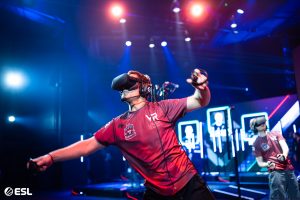
Leaping and ducking is all part of VR eSports
It has been two years since Oculus launched the VR League and in that time VR eSports has continued to grow immensely. Season 3 saw 451 unique players and 146 teams across the four games featured this season: Onward, Echo Arena, Echo Combat, and Space Junkies.
Chicken and egg situation
The final in Leicester, available to viewers live on Twitch, Facebook and YouTube, posed challenges for ESL UK. VR eSports is a subset of the overall genre. It is an early stage sport at this point, but is growing, comments James Dean, CEO of ESL UK. “This was a bit of a giant project, through our relationship with Facebook and Oculus. VR is an advancement in the immersive game experience. Gaming is one of the prevalent activities in VR; it’s something that is driving the technology.”
However, he adds VR is still a nascent gaming technology: “It’s a bit of a chicken or the egg situation. VR at this time is quite an expensive tech, but you need enough people with the hardware to consume the software, and people won’t buy the hardware unless there’s enough software to consume.”
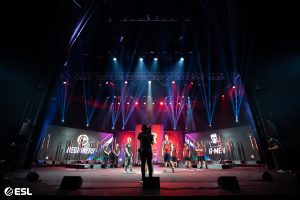
On the big stage at Haymarket, Leicester, UK, for the VR League finals with ESL and Oculus
Getting VR eSports onto a screen that viewers in-stadium or on social media can appreciate is no simple task; it is necessary to capture not only the gameplay and the reaction of the player as required in ‘traditional’ eSport broadcasting, but also the player ducking, jumping, rolling, mimicking reloading, firing and more in order to play.
Pushing broadcasting boundaries
Viewers want to see the correlation of how the physical movements of the players affect the gameplay, notes Dean: “What’s exciting about this [VR gaming] is it really pushes the broadcast element; it’s like normal eSports, but VR isn’t just about the gameplay. If you compare VR game Onward [one of the VR League games] to Counterstrike, both are first-person shooters, but Onward is relatively slow paced. But as soon as you see people are rolling around on the floor [playing Onward], grabbing ‘grenades’ and throwing them, carrying out actual physical movements, dodging and crouching, it all becomes very, very physical, and super interesting because it’s not just the gameplay that you have to capture, it’s what’s happening in the physical space as well.
“In traditional eSports, what we’re looking for currently is player reaction, looking shocked as they do something. What we’re doing at this point on a broadcast level is putting a picture on picture of the gameplay and the player themselves. But VR completely transposes that in a physical way,” said Dean. “For the first time we’re seeing the narrative in the physical realm and capturing that; it’s just as important as what [the player] is doing in the game. For instance, how quickly did they react and crouch? Physically this all matters, massively; did they duck quick enough? It’s about the convergence between physical sports and eSports.”
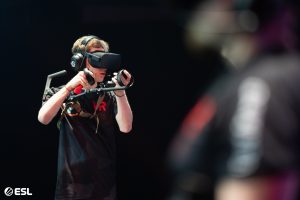
Bang, bang, you’re dead!
This added requirement to cover the physicality of VR eSports puts pressure on the broadcast element, says Dean, to the point where the level of equipment needed is something that a major broadcaster of a global event would need. “We’re in a situation where we’re having to handle a crazy number of inputs and settings. The traditional [eSports] broadcast set up can’t handle that; well, it can, but it’s very expensive, requiring top end stacks of equipment which just becomes silly. If we could afford all that it would be the same as saying let’s do an Olympic broadcast.”
Added Rob Stevens, ESL UK CTO: “In competitive gaming when using VR, letting the spectators see what the player is doing on stage is just as important as seeing the footage from in the game. Traditional eSports use cameras in-game to see player reactions, while in VR eSports they want to see realistic movements, such as crouching, jumping or even lying down.”
Upping the workflow game
Stevens noted: “Our old workflow wouldn’t come close to being able to handle the number of cameras we used for this show. The task in front of us was huge.”
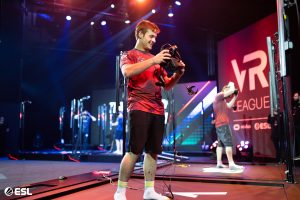
Gamers get ready for action at the VR League finals
ESL UK delivered the production relying on a Black Magic Design workflow that featured the ATEM Constellation 8K, a product that enabled the gaming company to bring all the elements of play to viewers. The new ATEM Constellation 8K is an ultra HD live production switcher with 4 M/Es, 40 12G‑SDI inputs, 24 12G‑SDI aux outputs, four DVEs, 16 keyers, four media players, four multi viewers, two SuperSource and standards conversion on every SDI input. When switched to 8K, all these features combine to make a powerful 8K switcher.
Stevens said: “The sheer size of the VR League show means that we needed a mixer bigger than our traditional Blackmagic ATEM 4M/E. Luckily Blackmagic has recently revealed their new ATEM 8K Constellation, and even though it was not shipping they sent us a model for us to get the show going with.
“Why? Because our standard mixer allows for 20 inputs, while the VR League required 23 for cameras alone,” noted Stevens on the scale of what ESL UK was trying to achieve.
The production included: 10 player cameras for constant access to see what position or actions the players were using in game; five cameras for the desk host and casters; two front of house cameras for wides and player close ups; one Spidercam; one shoulder camera; and four PTZ cameras for low down, dynamic stage shots that no other cameras could reach. Camera hire and services were provided by High Viz Media (Group), while a Spidercam was provided by Alan Wells Camera Services.
Stevens continued: “After that we still required inputs for our in games observers, graphics channels, replay system and video play out; tallying 31 inputs. This would normally require a large very expensive mixer to run, but Blackmagic’s 8K constellation comes in at £7,500 making even the biggest shows a reality on a good budget.”
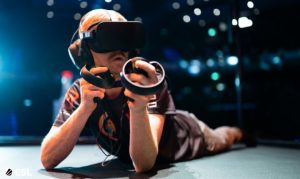
VR eSports bridges the gap between traditional sports and eSports
He added that the multiple aspects of each player’s movements in the real and virtual world were bought to viewers with the ATEM Constellation 8K: “This was achieved by using the Constellation’s new addition of two SuperSources, allowing each observer [one of ESL UK’s live show editors] to cut in-game to players at the same time as out of game cameras, without large amounts of scripting.”
Bladerunner is coming
Going forward, VR eSports is going to be about balancing the desire to pull out all the stops on broadcasts with the size of the market for this kind of event, concluded Dean: “There are two stems here: one stem is that this new thing is happening, converging physical sports with eSports; the second stem is how do we evolve the broadcast and innovate on a budget?
“The problem is, this is an emerging eSport. It’s a subset of eSports. It’s on the up, more people are playing, but the challenge for us is that we want all the technology but we don’t have the budget for the latest AR, camera tracking tech, handling an exponential number of inputs and the rest of it. This was the first time we have tried to see how physical actions affect virtual gameplay,” Dean added.
“We’re just scratching the surface here in terms of the possibility of where VR broadcasting is going. There could be complete VR environments, virtual sets, augmented reality; we can take every kind of cutting edge technology in the broadcast space and beyond and put that to purpose. We need to start exploring how we augment the player. There is so much to explore and figure out, such as camera tracking, motion tracking of people, and data points as the graphics side will be really interesting; how the data generated by the physical side effects the gameplay, and how to get that onto the screen.”
The future for VR eSport broadcasts is going to be like the set of Bladerunner, according to Dean, who noted: “Fast forward five to 10 years and I wouldn’t be too surprised if there were people running around some kind of stadium pitch, while they were playing a game. It’s happening and it’s really exciting.”
However, to get to that stage, some things need to fall into place technologically, said Dean: “I need unlimited tecnologyh and access to it all. It needs to be accessible.”
